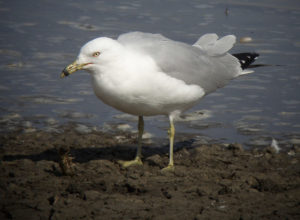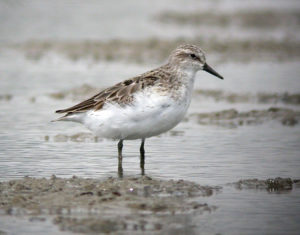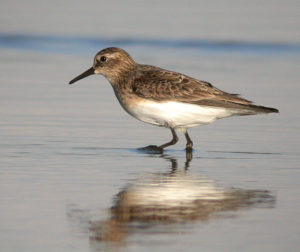Saturday mornings at Chatfield during the summer are a bit of a mixed bag. The number of ways in which people find to entertain themselves there are astounding, and the atmosphere can be quite circus like. Almost everywhere you look on land and water you see more people, and often birds are being flushed and forced to try and find calmer spots – no easy task.
Nonetheless, this can always be a great place to see a good variety of birds, and occasionally some really great rarities show up. You never know what you’ll see there and you just have to go and check it out. So, that’s what sixteen of us did on Saturday morning, eventually tallying 32 species.
So, we could have could have subtitled this walk as The Three Most Difficult Bird Groups to Identify: Fall Gulls, Shorebirds, and Sparrows, because, perhaps to the consternation of several of the participants, we ended up spending an inordinate amount of time struggling to identify birds in these three groups.
The gulls were perhaps the easiest, as we only had two species to deal with, but it is a harsh reality to realize that it takes most gulls 3-4 years to obtain adult plumage and there’s a lot of difficult identifications to wrestle with in the intervening years. So, not only did we see adult Ring-billed and California Gulls, but we also saw a 1st winter Ring-billed Gull, and a 3rd winter California Gull, and I’m sure we could have found even more with which to confuse ourselves. If this sort of masochism appeals to you make sure to come on some of our winter walks.
As for the sparrows, we did pretty well with the Lark Sparrows, even though they were mostly in their drab fall plumage, but then we ran into members of the Spizella genus. Yikes! Brewer’s, Clay-colored, and Chipping Sparrows are distinctive in breeding plumage, but things get very tough in the fall and really not something to which a nice bird walk leader subjects his/her participants. I’m not sure anyone got really good looks at these guys – not that it always helps – but learning to identify certain species at certain times of the year is not something that we can necessarily do without having spent hours (years?) of time in the field.
Finally, we got to the “peeps,” the little sandpipers. And at this point, I want to encourage all of you who are contemplating getting a spotting scope to please do so soon, as it is so helpful to have multiple eyes working on all aspects of identification of this potentially tough group of birds. So, we wrestled with: what color are the legs, how long is the bill, does it have an eye-ring, are the wings longer than the tail, etc…? And we came away with some degree of success.
So, congratulations to those of you who persevered with me on Saturday as we worked on some tough identifications, and I hope that you will all look forward to taking up that gauntlet again in the near future.
Good Birding! Chuck
Chatfield State Park, Sep 2, 2017
32 species
Canada Goose (Branta canadensis) 60
Gadwall (Mareca strepera) 2
Mallard (Anas platyrhynchos) 6
Green-winged Teal (Anas crecca) 4
Common Merganser (Mergus merganser) 8
Western Grebe (Aechmophorus occidentalis) 8
Double-crested Cormorant (Phalacrocorax auritus) 50
American White Pelican (Pelecanus erythrorhynchos) 50
Great Blue Heron (Ardea herodias) 1
Snowy Egret (Egretta thula) 6
Killdeer (Charadrius vociferus) 16
Baird’s Sandpiper (Calidris bairdii) 2
Least Sandpiper (Calidris minutilla) 1
Pectoral Sandpiper (Calidris melanotos) 1
Semipalmated Sandpiper (Calidris pusilla) 1
Spotted Sandpiper (Actitis macularius) 3
Ring-billed Gull (Larus delawarensis) 45
California Gull (Larus californicus) 7
Belted Kingfisher (Megaceryle alcyon) 2
Downy Woodpecker (Picoides pubescens) 1
Northern Flicker (Colaptes auratus) 4
Black-billed Magpie (Pica hudsonia) 9
American Crow (Corvus brachyrhynchos) 1
Black-capped Chickadee (Poecile atricapillus) 5
Yellow Warbler (Setophaga petechia) 2
Chipping Sparrow (Spizella passerina) 4
Clay-colored Sparrow (Spizella pallida) 1
Lark Sparrow (Chondestes grammacus) 7
Western Meadowlark (Sturnella neglecta) 2
Common Grackle (Quiscalus quiscula) 3
House Finch (Haemorhous mexicanus) 2
American Goldfinch (Spinus tristis) 1







Comments
Write Comment